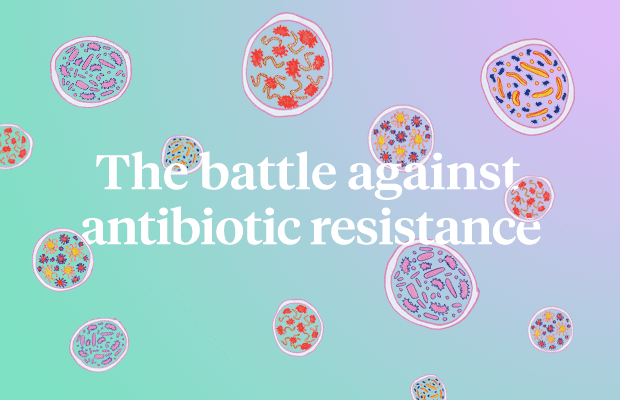In the last few decades, antibacterial resistance has risen at an astonishing rate, meaning that our world is now on the cusp of a post-antibiotic reality where even the most common infection could be deadly. Experts predict that by 2050, 10 million people will die from drug resistant infections per year, which is more than the current figures for cancer and diabetes deaths combined.
Antibiotic resistance occurs when bacteria adapt and grow in such a way that they become capable of surviving the action of antibiotic agents. These new resistant strains of bacteria can spread and thus certain infections become untreatable by the drug that once killed them.
The phenomenon of antibiotic resistance has been observed since the first discovery of antibiotic agents. However, the increased use of these drugs in modern society has caused resistance to develop much more rapidly. The overprescription of antibiotics, incorrect dosing or use by doctors and patients, as well as increased application of antibiotics in agriculture and animal livestock has lead to a terrifying increase in the prevalence spread of resistant bacterial strains.
A world without effective antibiotics would not only affect our ability to treat infectious disease, but would also compromise other essential medical procedures, including chemotherapy, invasive surgery and transplants that also rely on antibiotics. In a Global Action Plan Against Antibiotic Resistance released by the World Health Organisation (WHO) in 2016, Dr Margaret Chan, Director-General of WHO stated that “[Antibiotic] resistance threatens the very core of modern medicine and the sustainability of an effective, global public health response to the enduring threat from infectious diseases.”
Not only has antibiotic resistance been increasing, but drug development in this area has staggered drastically. In a so called ‘golden era’ of antibacterial development just after the discovery of penicillin, there was a huge increase in the number of antibiotic drugs becoming available. This influx lead many experts to (incorrectly) believe that infectious diseases were effectively ‘cured.’ As a result, broader drug development strategies shifted away from antibiotics.
The subsequent rise of the pharmaceutical industry and its continuous pursuit of “blockbuster drugs” and high profit margins has also contributed to a drastic drop in the amount of new antibiotics entering the market. Furthermore, many available drugs work in a similar way, thus resistance to one could mean resistance to many. The world therefore needs to push towards completely new and innovative therapies, a process which requires huge amounts of time and money.
We are now playing a game of catch up, to fill what Professor James Triccus, a microbiologist from The University of Sydney, describes as “a gap in discovery” in the antibiotic development space. It is clear that in order to fill this gap and fight resistance, a diverse range of strategies are required. Right here at the University, a large team of scientists is working on exactly this.
The National Health and Medical Research Council (NHMRC) has provided funding for a “Centre of Research Excellence” program specifically to work on infectious disease, which is also supported by the Marie Bashir Institute for Infectious Diseases and Biosecurity. The initiative aims to promote national and international collaboration and multidisciplinary research to overcome the problem.
As part of the initiative, Professor Triccus has developed a method to rapidly test new potential drugs against resistant strains of bacteria in his work at the Charles Perkins Centre (CPC). His team also works on sourcing new drug candidates from nature that have the ability to kill the bacteria that causes tuberculosis (TB), — the number one infectious killer in the world.
Professor Triccus has often worked in collaboration with Professor Richard Payne in The School of Chemistry, who makes new antibiotics in the laboratory with unique modes of action in order to develop innovative new treatments. Meanwhile, Professor Warwick Britton at the CPC is attacking the problem from a different angle, working on the development of vaccines against TB, aiming to develop stronger prevention strategies.
There are also clinicians at the Westmead campus who are researching ways to rapidly identify resistant strains of bacteria.
It’s the combination of all of these different strategies that strengthen our chances of combating antibiotic resistance. Professor Triccus claims that “unless we accelerate our work and see greater global investment, awareness and productivity, we may soon have many untreatable infections, that’s the reality.”





